Introduction
Pachypodiums are from the Apocynaceae Family or what is commonly called the Periwinkle family. Some of the more commonly known plants from this family are Periwinkles, Desert Rose, Plumeria and Oleander. Pacyhpodiums occur on the African Continent and on the island of Madagascar. There are 4 species of African Pachypodiums: Succulentum, Bispinosum, Namaquanum and Lealii. There is also one subspecies called the Lealii Saundersii. All occur in the southern part of the continent mainly in South Africa. All other Pachypodiums are Madagascan species. Pachypodium means 'thick foot'. It is often mistaken for a cactus, but it is a succulent. All cactus are succulents but not all succulents are cactus. The spiny varieties of pachypodiums are poisonous, minor irritation occurs at the point where the the needles enter the skin, a short period of numbness may also occur in the area where pricked.
Since pachypodiums are from tropical climates they are not adapted to cooler climates where occasional frost might occur. They tend to like warm sunny climates and will thrive if given plenty of water. They are deciduos and will lose all their leaves if the temperature drops to 40 degrees or below just as trees do in the fall. This is not a sign that the plant is dying as many folks tend to fear. The leaves may also fall if left dry for too long. This is a defense mechanism that helps the plant conserve water during dry seasons. It is best to water these plants just when the soil is drying out. The roots are tender and can be lost if they are left to dry out too long. Over watering is a common problem in the fall and winter. The roots will also be lost if the soil is too wet for an extended period of time. Finding the right balance takes a bit of practice. Cut back on the water as the temperatures drop in the Fall, as the plant is entering a rest period and simply does not need as much water.
Starting plants from seed is fairly easy if you can find fresh seeds. Plant as early as possible and maintain a warm soil temperature to ensure the best germination rates. Growth rates vary by species, Lamerii, Geayi, Rutenbergianum and the African species all tend to grow the fastest at up to 12 inches a year. While the Rosulatums and Densiflorum grow slower and Brevicaule the slowest.
Once your Pachypodium reaches flowering age you can expect to be rewarded with the nicest of sights and scents. Should you be lucky enough to have the flowers set seed you will see two horn like pods that will contain hundreds of seeds.
With the massive deforestation of Madagascar that has taken place over the last century, it seems imperative to act to broadly cultivate the species in order for it to survive. Several species are considered endangered in their native habitat.
Source: www.pachypodium.org
Since pachypodiums are from tropical climates they are not adapted to cooler climates where occasional frost might occur. They tend to like warm sunny climates and will thrive if given plenty of water. They are deciduos and will lose all their leaves if the temperature drops to 40 degrees or below just as trees do in the fall. This is not a sign that the plant is dying as many folks tend to fear. The leaves may also fall if left dry for too long. This is a defense mechanism that helps the plant conserve water during dry seasons. It is best to water these plants just when the soil is drying out. The roots are tender and can be lost if they are left to dry out too long. Over watering is a common problem in the fall and winter. The roots will also be lost if the soil is too wet for an extended period of time. Finding the right balance takes a bit of practice. Cut back on the water as the temperatures drop in the Fall, as the plant is entering a rest period and simply does not need as much water.
Starting plants from seed is fairly easy if you can find fresh seeds. Plant as early as possible and maintain a warm soil temperature to ensure the best germination rates. Growth rates vary by species, Lamerii, Geayi, Rutenbergianum and the African species all tend to grow the fastest at up to 12 inches a year. While the Rosulatums and Densiflorum grow slower and Brevicaule the slowest.
Once your Pachypodium reaches flowering age you can expect to be rewarded with the nicest of sights and scents. Should you be lucky enough to have the flowers set seed you will see two horn like pods that will contain hundreds of seeds.
With the massive deforestation of Madagascar that has taken place over the last century, it seems imperative to act to broadly cultivate the species in order for it to survive. Several species are considered endangered in their native habitat.
Source: www.pachypodium.org
Pachypodium species
1. Pachypodium ambongense
2. Pachypodium baronii var. baronii
3. Pachypodium baronii var. windsorii
4. Pachypodium bicolor
5. Pachypodium bispinosum
6. Pachypodium brevicaule
7. Pachypodium brevicaule var. leucoxanthum
8. Pachypodium decaryi
9. Pachypodium densiflorum var. densiflorum
10. Pachypodium densiflorum var. brevicalyx
11. Pachypodium eburneum
12. Pachypodium geayii
13. Pachypodium geayii var. mikea
14. Pachypodium horombense
15. Pachypodium inopinatum
16. Pachypodium lamerii var. lamerii
17. Pachypodium lamerii var. fiherenense
18. Pachypodium lamerii var. ramosum
19. Pachypodium lealii var. lealii
20. Pachypodium lealii var. saundersii
21. Pachypodium makayense
22. Pachypodium menabeum
23. Pachypodium namaquanum
24. Pachypodium rosulatum
25. Pachypodium rosulatum var. cactipes
26. Pachypodium rosulatum var drakeii
27. Pachypodium rosulatum var. gracilius
28. Pachypodium succulentum
29. Pachypodium succulentum var. griquense
30. Pachypodium rutenbergianum var. rutenbergianum
31. Pachypodium rutenbergianum var. meridionale
32. Pachypodium rutenbergianum var. sofiense
2. Pachypodium baronii var. baronii
3. Pachypodium baronii var. windsorii
4. Pachypodium bicolor
5. Pachypodium bispinosum
6. Pachypodium brevicaule
7. Pachypodium brevicaule var. leucoxanthum
8. Pachypodium decaryi
9. Pachypodium densiflorum var. densiflorum
10. Pachypodium densiflorum var. brevicalyx
11. Pachypodium eburneum
12. Pachypodium geayii
13. Pachypodium geayii var. mikea
14. Pachypodium horombense
15. Pachypodium inopinatum
16. Pachypodium lamerii var. lamerii
17. Pachypodium lamerii var. fiherenense
18. Pachypodium lamerii var. ramosum
19. Pachypodium lealii var. lealii
20. Pachypodium lealii var. saundersii
21. Pachypodium makayense
22. Pachypodium menabeum
23. Pachypodium namaquanum
24. Pachypodium rosulatum
25. Pachypodium rosulatum var. cactipes
26. Pachypodium rosulatum var drakeii
27. Pachypodium rosulatum var. gracilius
28. Pachypodium succulentum
29. Pachypodium succulentum var. griquense
30. Pachypodium rutenbergianum var. rutenbergianum
31. Pachypodium rutenbergianum var. meridionale
32. Pachypodium rutenbergianum var. sofiense
Pachypodium baronii var. windsorii
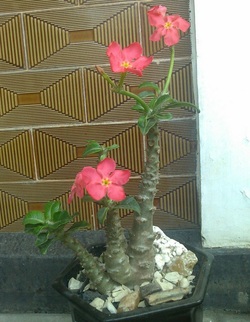
Windsorii is a spectacular plant. It is a variation of the baronii species and has its same tapered shape and brilliant red flowers. This variety has a more bulbous base than the type plant. The leaves also form a swirl around the top of the plant and the tip of the branches which are more frequent than in Baronii. The conical spines are fairly short located on the branches and not the base. The trunk is light green as a seedling becoming brown with maturity.
Habitat: Northern Madagascar.
Photo courtesy of Hendick Purwanto ([email protected])
Habitat: Northern Madagascar.
Photo courtesy of Hendick Purwanto ([email protected])
Pachypodium cf. eburneum
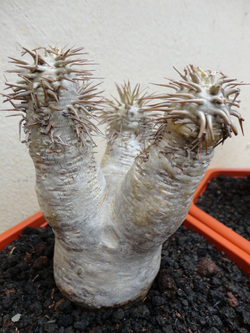
_ This pachypodium is similar in appearance to densiflorum and eburneum with the white flower
Pachypodium decaryi
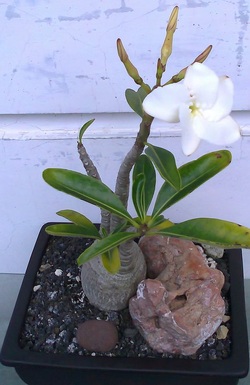
Described by Henri Louis Poisson in 1922.Growing on bare rocks with some water and lots of sun. The caudex can grow to 40 centimetres in diameter, the stem up to three or even four meters. The leaves form a swirl around the top of the plant and the tip of the branches. The spines are located onnew growth and fall with the leaves leaving a smooth trunk and branch. The trunk is a light, silver green upright pachycaul with a bulbous base that branches. This species has white salverform flowers that are formed in groups similar to the saundersii. The flowers are white with a yellow center and emit a pleasant scent
Habitat: Central Madagascar
Photo courtesy of Hendick Purwanto ([email protected])
Habitat: Central Madagascar
Photo courtesy of Hendick Purwanto ([email protected])
Pachypodium densiflorum
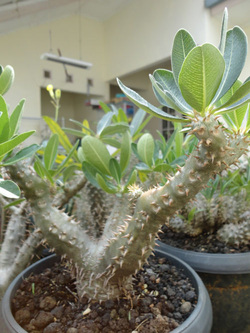
Described by John Gilbert Baker in 1886. It is found on Madagascar, growing in a well drained soil with some water and some sun. The stem will grow up to 30 centimetres in diameter and reach a height of 90 centimetres
Pachypodium densiflorum var. brevicalyx
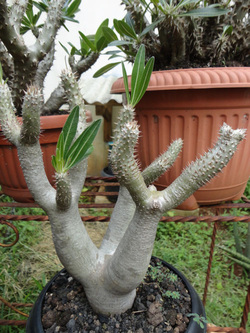
The appearances of this plant are virtually the same as that of the densiflorum with the exception of the flower. The yellow flowers of this variant are distinct in that the flower is a bit smaller and has more rounded petals. Brevicalyx should be given full light and plenty of water during the warmer months.
Habitat: central Madagascar.
Habitat: central Madagascar.
Pachypodium eburneum
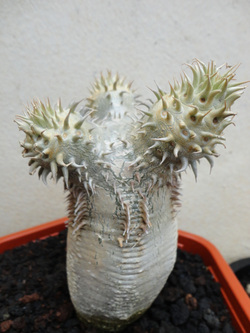
_Given the name by John Jacob Lavranos &
S.H.J.V. Rapanarivo in 1997.
The caudex can grow to 25 centimetres in diameter, and given sun enough, it won't grow much higher. The flowers are white to cream.
Habitat: Mt. Ibity in the Central Madagascar
The caudex can grow to 25 centimetres in diameter, and given sun enough, it won't grow much higher. The flowers are white to cream.
Habitat: Mt. Ibity in the Central Madagascar
Pachypodium horombense
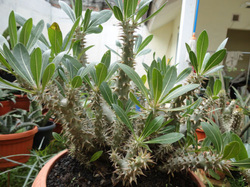
Horombense is a more compact plant than that of the rosulatum, but has many similarities. The deciduous leaves are narrow, but not as long the rosulatum. The leaves are dark green with a lighter middle vein and form a rosette around the tips of branches. The trunk is smooth with conical spines and is greenish silver. Branching occurs more frequently and may start from the base.
Habitat: Madaascar
Habitat: Madaascar
Pachypodium inopinatum
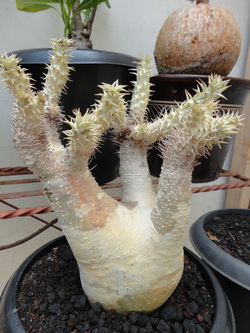
_
The deciduous leaves are oblong, narrow and dark green. The leaves have a
lighter middle vein and form a rosette around the tips of branches. The
trunk is a smooth bottle shape, is greenish silver and is smaller than
the type plant. Spines are conical. Branching occurs where the plant has
flowered. The flowers are what distinguises the variants of this
species. This variant has larger white flowers in clusters on shorter
peduncles. Inopinatum means unexpected. Flowers will set in the second
or third year in good conditions.
Habitat: Madagascar
Habitat: Madagascar
Pachypodium inopinatum x densiflorum
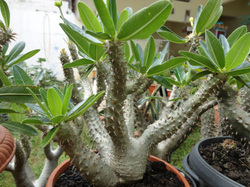
A Pachypodium hybrid with very beautyful yellow flower.
Pachypodium lamerii var. fiherenense
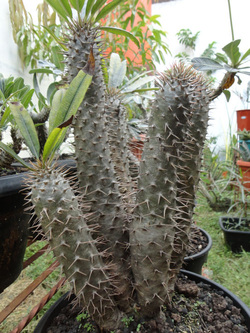
Form of Pachypodium lamerei which is fatter and shorter and flowers at a smaller height (at 1 - 2 metres height)
Pachypodium lamerii var. ramosum
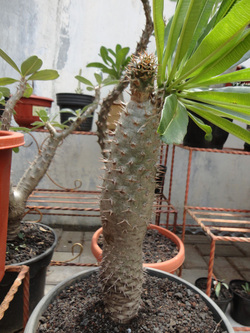
_The deciduous leaves are long. They are not as narrow as the lamerii
leaves with a bit less of a glossy look to them. The trunk is a smooth
greenish silver.
Habitat: Southern Madagascar
Habitat: Southern Madagascar
Pachypodium lealii var. lealii
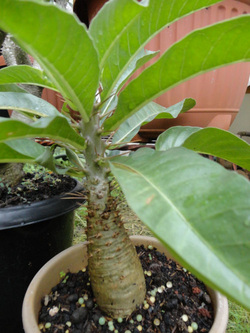
Described by Friedrich Martin Josef Welwitsch in 1869. It is found in Namibia and Southern Angola, growing in grit or other well drained soil with little water and lots of sun. The stem can grow to 1,5 meters in diameter and depending on the form; 50 centimetres to six meters height. The flowers are white to pale pink.
Named after the Portuguese geologist Fernando da Costa Leal, who first wrote about it.
Named after the Portuguese geologist Fernando da Costa Leal, who first wrote about it.
Pachypodium lealii var. saundersii
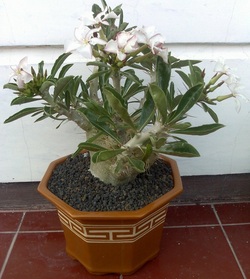
Described by Nicholas Edward Brown in 1892.
Growing in summertime in a well-drained soil with some water in summer, can do with some sun and stands lots of sun. The caudex gets 30 centimetres, the stems reaches one meter. The flowers are white, and it can only be reproduced by seeds. I found mine in Tokkerup in 2003. Pachypodium saundersii was named after a botanist who found it in South Africa in the late 1800's, Sir Charles Saunders..
Habitat: Southern Africa
Photo courtesy of Hendick Purwanto ([email protected])
Growing in summertime in a well-drained soil with some water in summer, can do with some sun and stands lots of sun. The caudex gets 30 centimetres, the stems reaches one meter. The flowers are white, and it can only be reproduced by seeds. I found mine in Tokkerup in 2003. Pachypodium saundersii was named after a botanist who found it in South Africa in the late 1800's, Sir Charles Saunders..
Habitat: Southern Africa
Photo courtesy of Hendick Purwanto ([email protected])
Pachypodium makayense
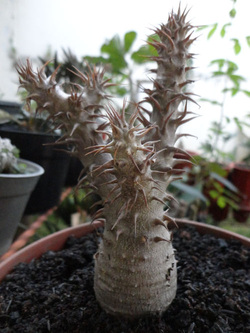
This second-most-recently described subspecies superficially resembles P. brevicaule in having dwarf caudiciform trunks broader than tall but with emergent branches with more persistent spines and inflorescences and fruits that are not as pubescent. It is named for the remote and largely unexplored Makay mountains where it grows. Plants collected Nov. 11, 2002, at 650 m in the Makay mountains of Tulear Prov., west-central Madagascar
Pachypodium namaquanum

Described by Friedrich Martin Josef Welwitsch in 1869.
The leaves are a light green, velvet texture with wavy edges occuring only near the top of the plant and on the tips of its few branches. The trunk is similar to lamerii but has far more spines and the color is more of a brownish green. Spines are in clusters of three where the leaves were located. This species is known for its unwillingness to adapt to the seasons of the Northern hemisphere, growing in the winter and resting in the summer. The flowers are a dull yellow with a purple tint in the center. Flowering is not common but will occur infrequently.
Habitat: South Africa.
Photo courtesy of Hendick Purwanto ([email protected])
The leaves are a light green, velvet texture with wavy edges occuring only near the top of the plant and on the tips of its few branches. The trunk is similar to lamerii but has far more spines and the color is more of a brownish green. Spines are in clusters of three where the leaves were located. This species is known for its unwillingness to adapt to the seasons of the Northern hemisphere, growing in the winter and resting in the summer. The flowers are a dull yellow with a purple tint in the center. Flowering is not common but will occur infrequently.
Habitat: South Africa.
Photo courtesy of Hendick Purwanto ([email protected])
Pachypodium rosulatum
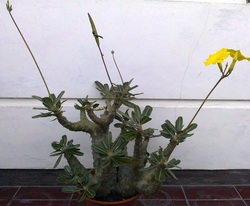
Described by John Gilbert Baker in 1882.
Growing in a well drained soil with some water and some sun. The stem will grow up to 10 centimetres in diameter and reach a height of 25 centimetres. The flowers are yellow.
Habitat: Madagascar
Photo courtesy of Hendick Purwanto ([email protected])
Growing in a well drained soil with some water and some sun. The stem will grow up to 10 centimetres in diameter and reach a height of 25 centimetres. The flowers are yellow.
Habitat: Madagascar
Photo courtesy of Hendick Purwanto ([email protected])
Pachypodium rosulatum var. cactipes
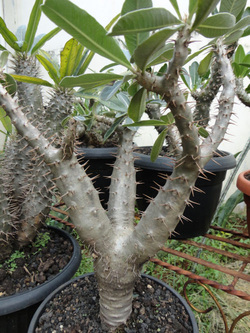
Pachypodium cactipes may merely represent a southerly form of the Pachypodium rosulatum complex but for now it is preferred to recognize it as a distinct species until further research clarifies its affinities. Its rich green glossy foliage, showy yellow flowers and ease of culture make it one of the more rewarding of the genus.
